The WFX-FIT test (Wildland Firefighter Fitness Test) is a rigorous physical exam designed to assess the abilities of those seeking to become Alberta Wildfire Firefighters. This test is a critical step in the recruitment process and focuses on evaluating the physical fitness needed for demanding tasks such as carrying equipment, dragging hoses, and responding quickly under pressure. Here, we’ll break down the key components of the test and how you can prepare to pass it.
The Alberta Wildfire Recruiting Process
Alberta Wildfire recruits wildland firefighters each season, with an emphasis on physical readiness, problem-solving, and teamwork. The application process includes:
- Submitting an online application
- Interview and situational assessment
- Fitness testing (including WFX-FIT)
Applicants must demonstrate both technical and physical competencies during the hiring process. Passing the WFX-FIT test is mandatory to ensure candidates can safely and effectively perform the physically demanding tasks involved in fighting wildfires.
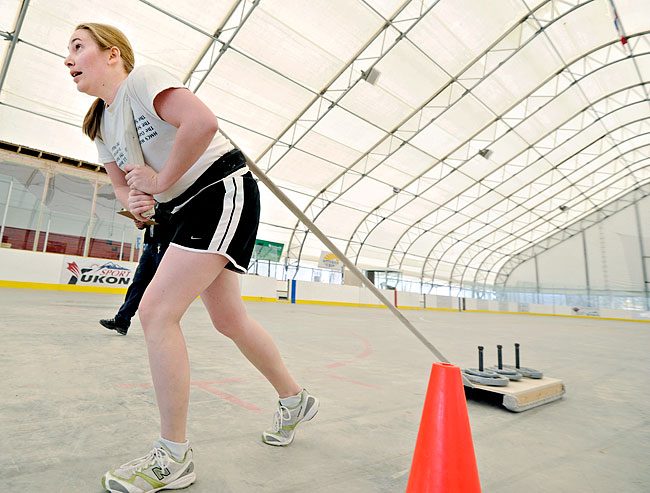
Key Components of the WFX-FIT Test
The WFX-FIT test simulates essential firefighting tasks, structured into timed stations that challenge cardiovascular endurance, muscular strength, and mental resilience.
Throughout the WFX-FIT circuit, the participant wears:
- Workout clothing
- Running shoes or work boots (if agency requirement)
- A weighted belt (4.2 kg) which encumbers the participant with
the weight of normal wildland fire line work wear
Here’s a breakdown of each station:
1) Carry Medium Pump on Back 160 m; 4 X 40 m over ramp 8 times
2) Hand Carry Medium Pump 80 m; 2 X 40 m over no ramps
3) Hose Pack Lift & Carry on Back 1 km; 25 X 40 m over ramp 50 times
4) Charged Hose Advance 80 m; 2 X 40 m over no ramps moderate
The timed circuit involves 4 separate performance components
performed in a continuous sequence over 40 m laps with pylons
markers at each 20 m end line.
Timing of the circuit begins when the participant crosses the starting line while carrying the simulation pump (28.5 kg) from a1m platform on their back. For safety purposes, the participant is assisted with the lifting and lowering of the pump onto and off their back. The simulation pump is carried on the back for a total of 160 m (4 laps over the 40 m course) traversing a ramp (35 degree pitch, 1.22 m) every 20 m, then the simulation pump is returned to the platform.
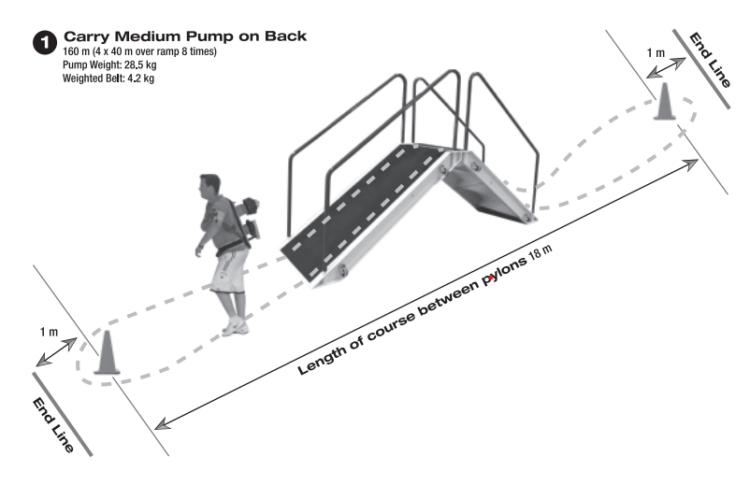
Next, the participant picks up the simulation pump from the platform in their hands and carries
it for 80 m (2 laps of the 40 m course) without traversing the ramp.
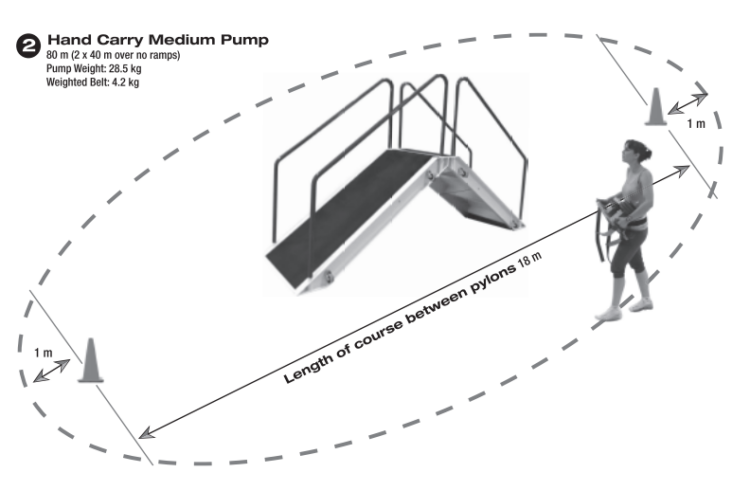
The participant then places the simulation pump back onto the platform, picks up the WFX-FIT
hose pack containing 4 lengths of hose (25kg) from the ground and hoists it onto their back,
then carries the hose pack 1 km (3281 ft) (25 laps of the 40 m course) traversing the ramp every
20 m.
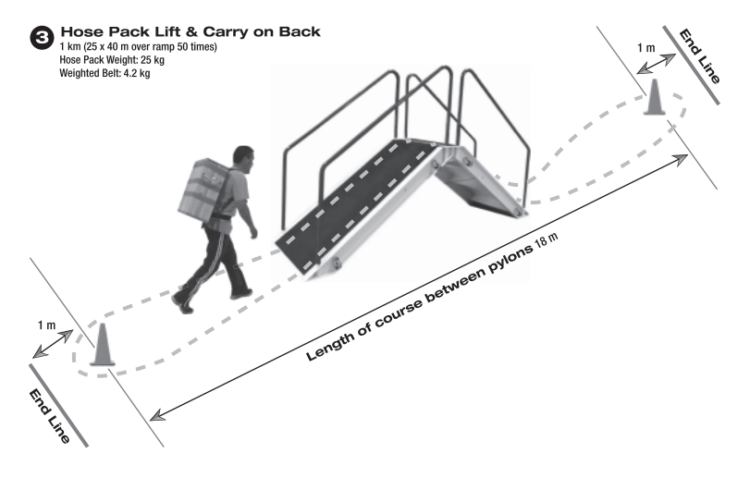
In the final component of the circuit, the participant drags a weighted sled 80 m (2 laps of the
40 m course) on level ground to simulate advancing a charged hose (pull force required to move
sled = 18.5 kg). Turn lines are also marked 3 m beyond the end line so the participant knows
when the sled has crossed the end line without looking behind.
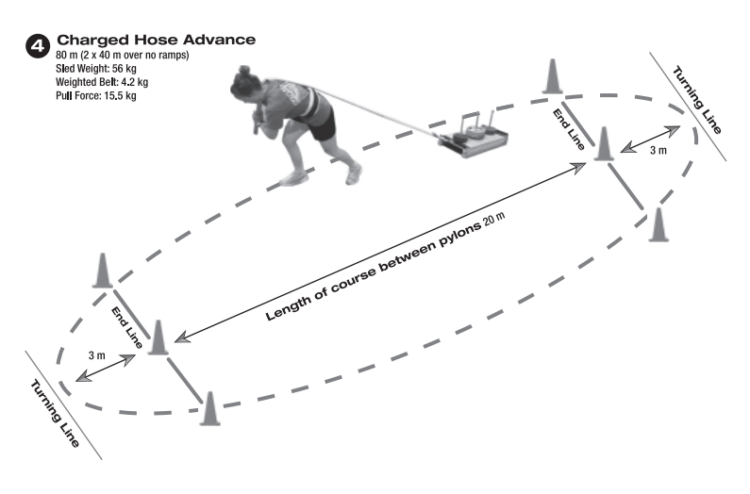
Each section must be completed within a strict time limit, and failure to meet these standards results in disqualification. Passing the WFX-FIT shows that you can endure the real-life physical demands of wildland firefighting.
How to Prepare for the WFX-FIT Test
Preparing for the WFX-FIT test requires a targeted training approach that builds both strength and cardiovascular endurance. Below are some tips for your preparation:
- Increase Aerobic Endurance
Given the emphasis on sustained effort, aerobic conditioning is essential. Regular cardiovascular workouts such as running, cycling, or high-intensity interval training (HIIT) will help you develop stamina for tasks like the step test. Aim to increase the duration and intensity of these workouts over time. Blue Line Fitness Testing has weekly fitness classes that will help you push yourself to the level you need to pass your WFX Fit Test. - Strength Training
A major portion of the WFX-FIT involves lifting and carrying heavy objects. Focus on weightlifting exercises that target key muscle groups:- Legs: Squats, lunges, and step-ups are great for simulating carrying heavy loads over uneven ground.
- Core: Exercises like planks, sit-ups, and weighted carries improve balance and support during demanding tasks.
- Upper Body: Push-ups, pull-ups, and deadlifts help build the necessary upper body strength for tasks like dragging hoses and carrying pumps.
- Functional Movements
Training that mimics real-world firefighting tasks is highly effective. Use weighted vests to perform step-ups, practice dragging heavy objects, and incorporate overhead pressing or pulling exercises to mimic hose drag tasks. Need help to master these movements? Our Blue Line coaches can help you out with one on one sessions! - Interval Training
The WFX-FIT test requires a balance between quick bursts of effort and sustained endurance. Implement interval training into your routine to build the stamina to transition quickly between test stations. Include exercises like tire flips, sled drags, or kettlebell carries. - Practice Mental Toughness
Firefighting demands more than just physical strength. Train your mind by pushing yourself in workouts, simulating the mental fatigue that may arise during the test. Incorporate activities that require problem-solving under physical stress to prepare for real-world challenges.
blue line fitness testing CAN HELP YOU PASS the wfx-FIT TEST IF YOU WANT TO become a wildfire firefighter IN CANADA.
Passing the WFX-FIT test is a significant step toward becoming an Alberta Wildfire Firefighter. With the right preparation focusing on strength, endurance, and functional fitness, you can meet the demands of the test and thrive in this high-intensity role. Structured training programs and understanding the specifics of the test will give you the best chance of success and start preparing EARLY to give yourself time to build up the fitness levels required to ace your test! To learn more details and access the official test guidelines, visit the CIFFC website.
Start your preparation with Blue Line today, and take the first step toward joining Alberta Wildfire’s elite firefighting team. Blue Line has experienced instructors and certified coaches who know exactly how to get people into the physical and mental condition they need to pass their fitness testing as part of any law enforcement or first responder entrance testing protocols.
Are you ready to run and pass your Fitness Test? Contact us today to start your journey towards your law enforcement career.
For more information on any of the fitness testing Blue Line offers, check out these pages and posts:
PARE Testing Alberta page
How the Pass the PARE in Alberta
Listen to our podcast Sirens, Slammers and Service – Season 2 – Wildfire Fighting with Kris and Kendra to learn what a wildfire firefighter does on a daily basis!







